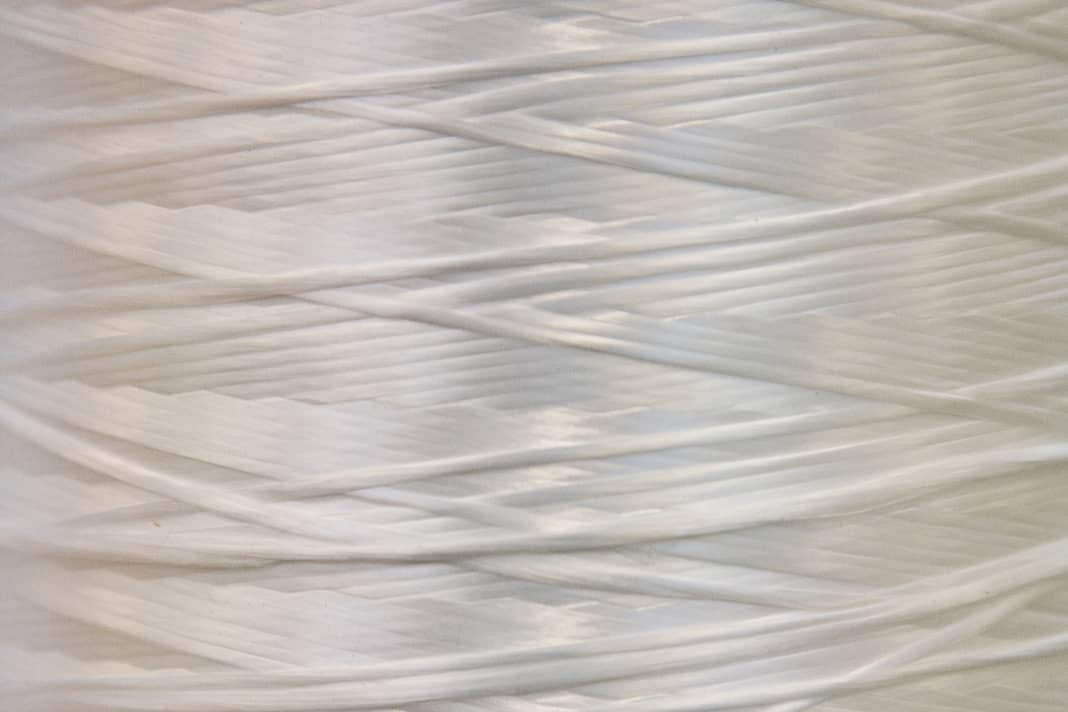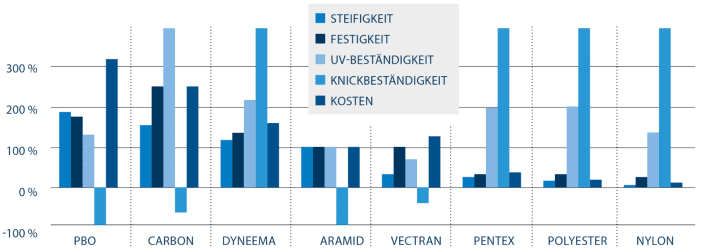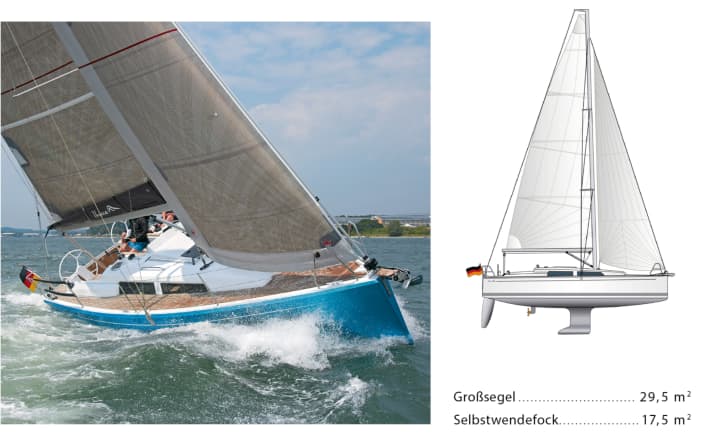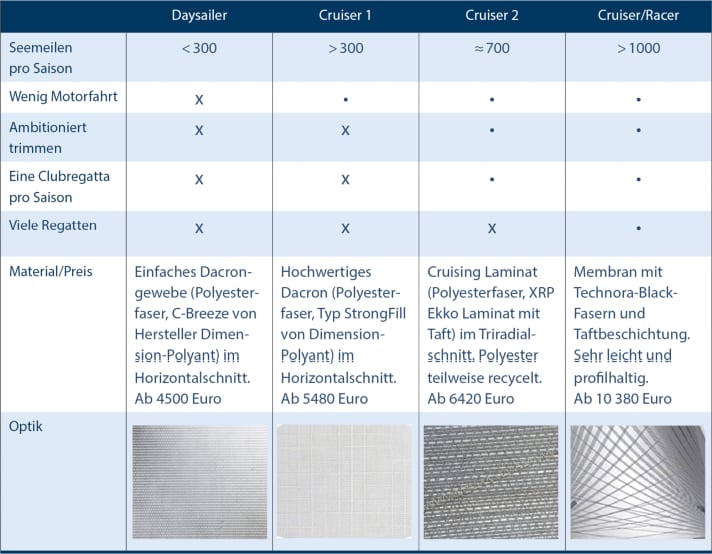




This article is part of a sailing special. The contents:
The time often comes sooner than you think. The sail is no longer optimised and needs to be replaced. Owners certainly have very different views on when this is the case. Many used boats still have the original sail wardrobe attached, which usually continues to do its job even after more than 20 years, and replacement is only considered when the seams become brittle and patching is no longer an option. However, the profile has not been ideal for a long time. By stretching the fabric, the entire sail becomes more bulbous and the deepest point moves from the first third behind the luff to the centre of the cloth. As the sail can then no longer be trimmed flat and the profile is shifted, it generates more pressure but less propulsion. As a result, the sail has to be reefed earlier. In addition to the loss of performance, comfort also suffers.
When assessing a used sail, it is therefore important to look at the profile and the condition of the material. With sails made of polyester fabric (Dacron), the profile loses its shape more quickly, but the cloth itself is extremely durable and can last for decades without major damage. Depending on the fibre used, laminate sails keep their profile significantly longer, but they will eventually break down mechanically due to delamination. If you can decide to postpone the purchase of a new Dacron cloth despite a deformed profile, this is not possible with a defective laminate sail. However, the latter retains its profile almost until the mechanical end of its service life.
The most important criteria for choosing a new sail
This aspect also plays an important role in the choice of sailcloth. New sailcloth is an expensive purchase, but it should not be forgotten that the sails are the main drive of the yacht. However, the choice depends not only on money, but especially on the use of the boat. If the boat is only used as a daysailer on an inland sailing area or is used rather infrequently, even inexpensive products will certainly last quite a long time. For active regatta sailors, on the other hand, high-quality cloths are almost mandatory. However, cruising sailors also benefit from a low-profile and low-stretch wardrobe. After all, well-trimmed sails that propel the boat quickly upwind can make the difference between a great day's sailing that brings you closer to your destination and a day in harbour due to unfavourable wind direction.
Sailcloth has different properties depending on the fibre used and how it is processed. The main criteria are strength, elongation, UV resistance, kink resistance and price. The strength determines how much fibre has to be used per square metre of sail and therefore determines the profile stability and weight of the cloth - the more stable the fibre, the better a lightweight sail will hold its profile. The profile stability also depends in particular on the elongation of the fibres under load. Resistance to buckling and UV resistance are decisive factors in the lifespan of the cloth. Of course, the price also plays an important role, although it cannot be said that a particularly expensive sail will last the longest. In addition to the fibre, the cut of the finished sail also plays an important role. However, the processing is also particularly decisive for the properties of the sail.
Fabric, laminate or membrane: spoilt for choice
There are two main differences here: woven fabrics and laminates. The former are classic fabrics made from warp and weft yarns, usually polyester. However, other fibres can also be incorporated, in which case they are referred to as hybrid fabrics. In the case of laminates, the fibres are placed in the load path as far as possible and bonded with film. Mylar film, for example, can be used. Whether one or two films are used also varies. Additional finishing with taffeta ensures larger bending radii and protects the fibres from breaking when packing the sail and from abrasion. There are many possible fibre blends and production methods that enable a wide range of applications.
As soon as sails are not white, but grey or black, it gets expensive. But what are common materials?






The most common fabrics for cruising yachts are polyester fabrics. The fibre is very resistant, it can withstand creases and UV radiation for a long time and the price is also low. However, polyester stretches quite a lot under load. Special weaves, more fibre per square metre or the addition of Dyneema can also make Dacron sails very profiled. A well-known fabric variant is Hydranet from Dimension-Polyant. Dyneema fibres are extremely stable, hardly stretch at all and are kink and UV resistant. However, the price is significantly higher than for polyester. Dyneema is also used in laminates. The disadvantage is that it can creep under prolonged heavy loads and thus change its profile.
Kevlar is an aramid fibre, low-stretch and high-strength, good for high-performance laminate sails. However, the fibres are susceptible to kinking and UV damage. Everything speaks in favour of regatta sails that need to perform well but also need to be regularly renewed.
The best material for new sails: Is carbon fibre unbeatable?
Technora Black is another aramid fibre, but it has slightly better folding properties and is not as sensitive to UV radiation. This makes it suitable for cruising laminates - similar to Vectran fibres, which are based on polyester but are between polyester and aramid in terms of structure and strength and are quite robust against UV radiation and buckling.
The absolute frontrunner in terms of strength, low stretch and UV stability is carbon fibre. But this material also has two disadvantages: The fibres are quite brittle, so they can break easily, and they are also very expensive. Sails made of carbon fibre are very true to profile, light, but not particularly durable compared to polyester.
Nylon fibres are an exception, as they are very strong, but have a lot of stretch. This stretch is acceptable for gennakers and spinnakers. In addition, the fabric must be light so that the sail remains stable even in light winds. Due to the lower apparent wind on cruising yachts, these sails tend to be used in light winds. The thermoplastic polyamides (nylon is the trade name) are very resistant to buckling and abrasion. However, they are not suitable for upwind sails.
A direct comparison of the different materials and processing methods

The diagram above shows the most common materials for sails. Polyester has its strengths in UV and kink resistance and is by far the cheapest fibre. However, aramid (Kevlar), Dyneema and especially carbon are stronger and stiffer - properties that come at a price. For larger cruising sails, Dyneema, which is based on polyethylene, is a good alternative to both polyester and carbon. Especially as carbon is so strong and stiff that the other fittings on board should be matched to it. Nylon is only used for room sheet sails.
Example from Elvstrøm: Amwind wardrobes for four different user profiles using the example of a Hanse:


The price: How much can the sail cost?
Any laminate, whether with film or not, can be protected with taffeta for longer durability. The polyester fleece protects against buckling and UV radiation. The equipment, such as continuous battens, better slides, leech tapes, wind tapes, windows and reinforcements, is also individual for each sail and ultimately affects the price. But how expensive should a sail be? If you want to compare offers from simple cloth to performance-orientated laminate, Sören Hansen from Elvstrøm says: "I can easily name 50 different types of sail. It's not that easy to reduce the choice to just a few possible outcomes. It's important to consult the sailmaker: how much sailing do you do each season, do you actively trim your sails, do you want to compete in regattas?"
Sascha Schwarck from Elvstrøm Deutschland in Heiligenhafen provides four examples (see box above). He emphasises that although a ready-made sail is available at the prices quoted, there may still be major differences in the final bill due to individual equipment. The first two application profiles with fewer miles per year, no regattas and rather unambitious trim are equipped with polyester fabrics in a horizontal cut. The difference lies in the fabric quality. Profiles three and four are fitted with laminates, the latter even with Technora Black fibres. This is reflected in the price: the performance fabric costs more than twice as much as the cheaper polyester fabric. The price range extends from 4,500 to 10,380 euros - a huge difference. Even if the budget allows for it, the most expensive one is not necessarily the best choice. A new, well-fitted sail brings more sailing fun and comfort to any boat. The choice of material determines how long these benefits last.

